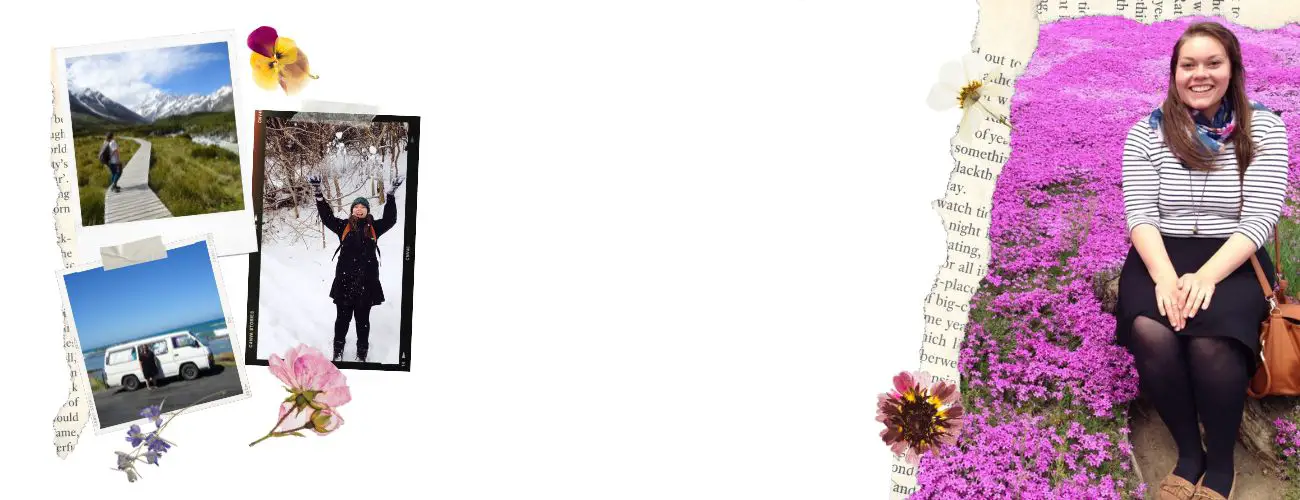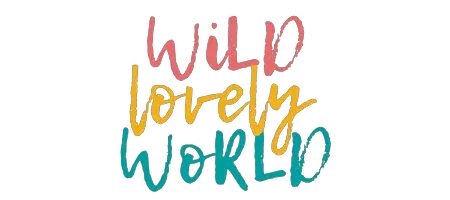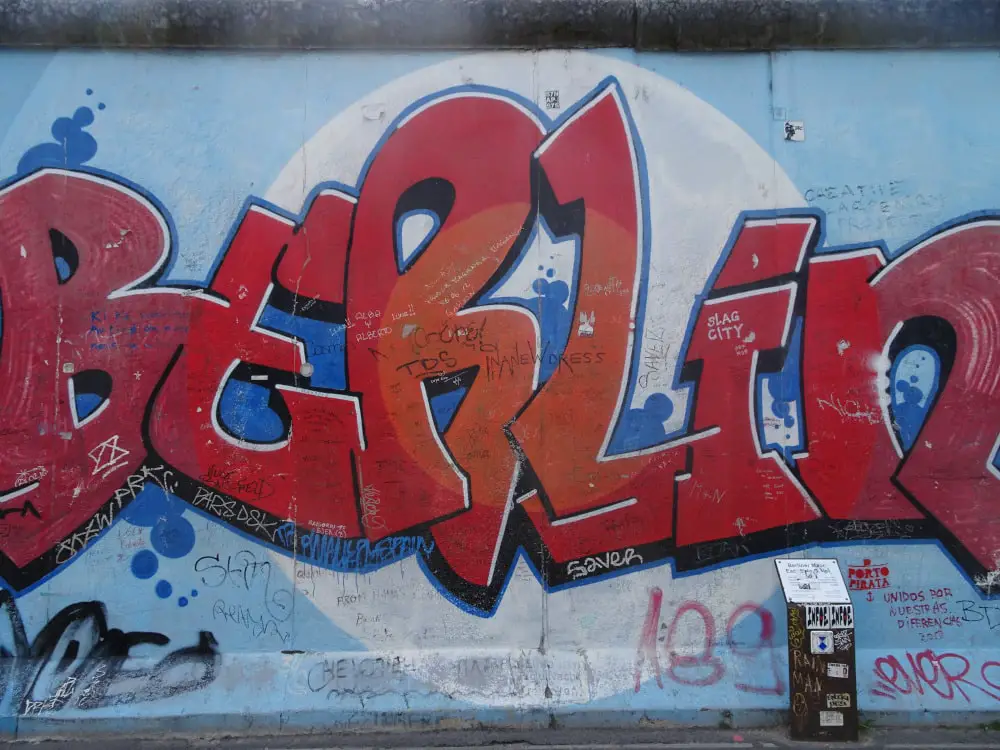
Free Self-Guided World War II Walking/Cycling Tour In Berlin
Discover the history of Berlin at your own pace with this FREE self-guided tour around the main sights and landmarks in Berlin of the events before, during and after World War II. Highlights on this tour include the Berlin Wall, the Memorial to the Murdered Jews and Hitler’s Bunker.
You can follow the route on the map by cycling or on foot. Learn along the way by reading the information about each location below.
I created this free self-guided tour after visiting Berlin and discovering all of the World War II memorials and historical locations for myself. Berlin is a very interesting city to visit, and I thoroughly enjoyed my time there. I learned a lot about the history of World War II and Berlin. This guide has been put together from my own experience and research. I hope you enjoy this free self-guided walking/cycling tour and get the most out of your visit to Berlin.
FREE Self-Guided World War II Walking/Cycling Tour In Berlin
How To Use This Free Self-Guided Berlin World War II Walking/Cycling Tour
This guide includes two parts – a custom-made map on Google showing the route and locations in Berlin, and this blog post which explains the significance of each location
Before you go, download this guide for offline viewing, print paper copies or take screenshots.
For the map, you can follow the route on Google Maps here in real-time if you have mobile phone data or download the map PDF. With the PDF you could print a paper copy, save it on your phone or take screenshots.
At each stop on the route, read the accompanying information in this blog post to learn about each site and its history in World War II.
Virtual Berlin World War II Self-Guided Tour
If you are not going to Berlin, you could even do this tour virtually! Follow the route on Google Street View and read about each stop in this blog post along the way.
What Will I See On The Free World War II Tour In Berlin?
This tour starts at the East Side Gallery and finishes at the Church of Reconciliation at the Berlin Wall Memorial. Here’s a list of what you’ll see on the way:
- A. East Side Gallery
- B. Checkpoint ‘Charlie’
- C. Topography of Terror
- D. Hitler’s Bunker
- E. Memorial to the Murdered Jews of Europe
- F. Brandenburg Gate
- G. Memorial to May 10, 1933
- H. Berlin Wall Memorial
- I. Ackerstrasse
- J. Church of Reconciliation
The letters correspond to the stops marked on the Map. This guide also shows photos of each location in Berlin that I took myself.
How Should I Travel (Walking Or Cycling)? & How Long Will It Take To Do The Self-Guided World War II Tour In Berlin?
You can do this self-guided tour by walking or cycling. I would recommend cycling if you can but if you prefer walking you will get the same experience, it will just be at a slower pace!
In total, it would be around 1 hour of cycle time and 2.5 hours of walking time going directly from location to location. So you could make this a full-day itinerary, a half-day, or just a couple of hours, depending on how long you choose to spend at each stop!
In most of the locations, you could spend anything from 5 minutes to 1 hour. The Topography of Terror museum (link to their website) has FREE entry and is worth spending 2-3 hours to fully see the exhibitions (FREE audio guide included). The Memorial to Murdered Jews museum (link to their website) has FREE entry and could take around 1-2 hours (audio guide included).
Journey Times By Bike & On Foot
- Start at the East Side Gallery.
- A-B East Side Gallery to Checkpoint ‘Charlie’ – 17 min cycle/60 min walk.
- B-C Checkpoint ‘Charlie’ to Topography of Terror – 2 min cycle/5 min walk.
- C-D Topography of Terror to Hitler’s Bunker – 4 min cycle/10 min walk.
- D-E Hitler’s Bunker to Memorial to Murdered Jews – 1 min cycle/4 min walk.
- E-F Memorial to Murdered Jews to Brandenburg Gate – 3 min cycle/7 min walk.
- F-G Brandenburg Gate to Memorial to May 10, 1933 – 5 min cycle/15 min walk.
- G-H Memorial to May 10, 1933, to Berlin Wall Memorial – 10 min cycle/30 min walk.
- H-I Berlin Wall Memorial to Ackerstrasse – 2 min cycle/4 min walk.
- I-J Ackerstrasse to Church of Reconciliation – 1 min cycle/1 min walk.
- Finish at the Church of Reconciliation.
Map For Free Self-Guided World War II Walking/Cycling Tour In Berlin
I have created this custom Google Map below which shows the route and all locations on the self-guided World War II tour in Berlin.
Follow this route to each stop on the self-guided tour. There are 10 stops on the tour and these are marked in the colour purple. The route and directions are marked in the colour blue.
The tour starts at the East Side Gallery and ends at the Kapelle der Versöhnung (Church of Reconciliation).
Where To Rent A Bike In Berlin
Cycling is very popular in Berlin and there are many places to rent a bike.
During my stay in Berlin, I rented a bike from my hostel. I stayed at the EastSeven Hostel in Berlin (view photos and book this hostel on Booking and Hostelworld). I thought it was a really clean and friendly hostel in a great location for exploring Berlin.
You can rent bikes with a bike rental company as well. It is easy to book a bike rental in Berlin online in advance. This company offers 48 or 72-hour bike rental in Berlin (Get Your Guide) with helmets and maps to get you going.
Free Self-Guided World War II Walking/Cycling Tour In Berlin
Ready to do your free self-guided World War II tour of Berlin? Make sure you have the route map and this blog post handy. You can download the map and this blog post for offline use, print them or take screenshots.
Follow the route, beginning at location A and finishing at location J. Once you arrive at each location, just read the information section A-J to learn about each spot.
Okay, let’s go!
A. East Side Gallery
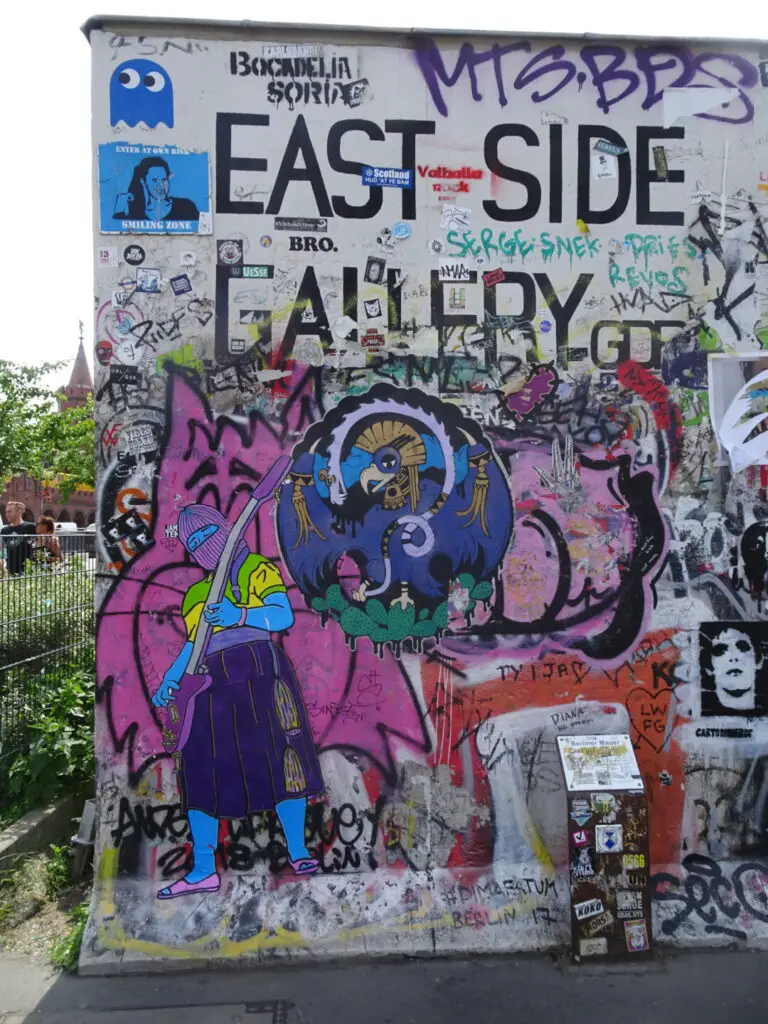
This self-guided Berlin World War II tour begins at the East Side Gallery!
The East Side Galley is the longest open-air gallery in the world. It is made of 1.3km from the original Berlin Wall which has been painted by artists from all over the world.
To fully appreciate the East Side Gallery, it’s important to understand the history of the Berlin Wall.
History Of The Berlin Wall
Once World War II ended in 1945, the East of Germany came under the control of the Soviet Union and the West of Germany was taken over by the US, Great Britain and France.
Although all of the city of Berlin was on the Eastern side, the city was split into two – east and west. The East of Berlin came under the control of the communist government of East Germany (the German Democratic Republic (GDR)) and the West of Berlin was controlled by the Western Allies.
Despite the different powers and tensions between them, for many years Berliners were able to move around freely in the city and cross the East-West border to work and shop. However, many people decided to try to leave East Berlin and move to the West, many of them young, skilled workers such as doctors and teachers.
The Building Of The Berlin Wall
East Germany was embarrassed by the seemingly endless flow of migrants trying to escape the GDR and live in West Berlin. In 1961, in an attempt to stop migrants from moving from East Berlin to West Berlin, the Berlin Wall was erected by East Germany. The goal was to form a division between the eastern communists and the western allies.
After the wall was built, it became almost impossible for people to move across the border. Crossings were only permitted at three checkpoints for Western Allies: Checkpoint ‘Alpha’ (West Germany – West Berlin), Checkpoint ‘Bravo’ (West Germany) and Checkpoint ‘Charlie’ (West Berlin – East Berlin) (the second stop on this tour). Checkpoint ‘Charlie’ was the only checkpoint that allowed entry into and exit from East Berlin for foreigners, diplomats and members of Allied forces. East German soldiers checked those entering and leaving and only under special circumstances were Berliners rarely allowed to cross the border.
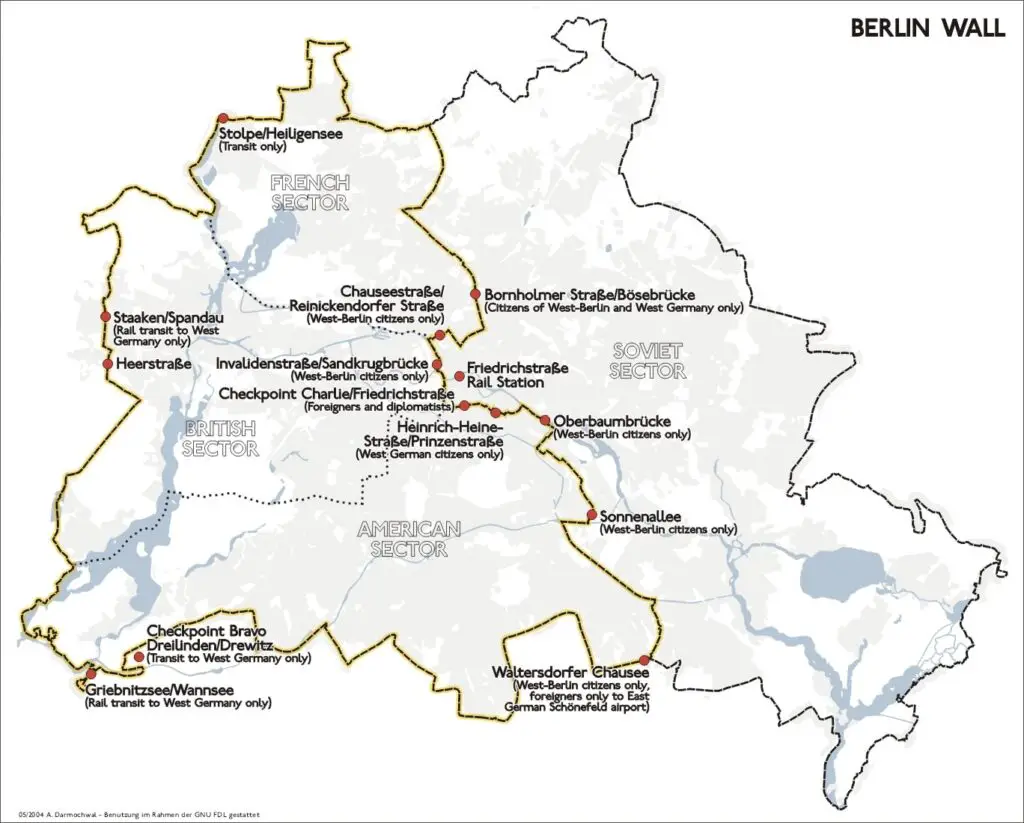
For 28 years the Berlin Wall divided the city at its very heart. The wall not only took away people’s freedom but many families and friends were separated on either side of the wall and had no hope of seeing one another.
Despite the scale of the wall and the dangers of trying to cross it, many people made attempts. At least 171 people were killed trying to cross the border, but more than 5,000 East Germans were successful in getting to West Germany.
The Fall Of The Berlin Wall
On 9th November 1989, as the Cold War began to come to an end, East Germany decided to allow citizens to cross the country’s borders. Upon hearing the news, many people went to the wall and flooded through the checkpoints. More than 2 million people from East Berlin went to West Berlin in the few days that followed in a huge celebration of freedom. People started to tear down the wall section by section.
Interested in learning more about the GDR and life in East Germany? You might like this post: 13 Weird & Wonderful Things To Do In Leipzig
The Creation Of The East Side Gallery
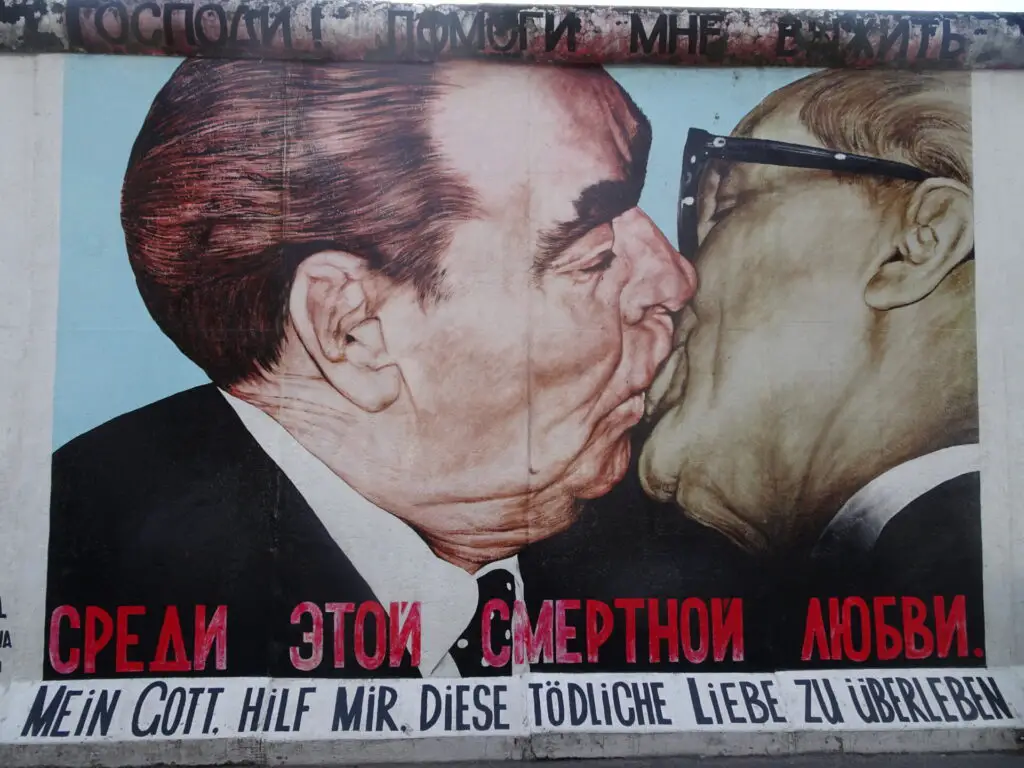
When the wall came down in 1989, 118 artists from 21 countries began painting the wall with murals. Using the oppressive concrete walls as a canvas was a powerful medium to express ideas of change, thoughts on freedom and hopes for the future.
The painted walls were officially opened as an open-air gallery on 28th September 1990.
On 3rd October 1990, East and West Germany were officially reunited.
A year later in 1991, the East Side Gallery section of the Berlin Wall was given protected memorial status.
It is the longest continuous section of the Berlin Wall still in existence.
As the wall is exposed to the elements, the wall is regularly restored and repainted to keep it looking fresh.
Many of the paintings depict artist comments on political change in 1989/90. Although all of them are fascinating to look at, some are more popular than others – such as Dmitri Vrubel’s Fraternal Kiss.
Enjoy your walk alongside the Berlin Wall viewing all of the art and murals painted on it before moving on to the next stop – Checkpoint ‘Charlie’.
B. Checkpoint ‘Charlie’
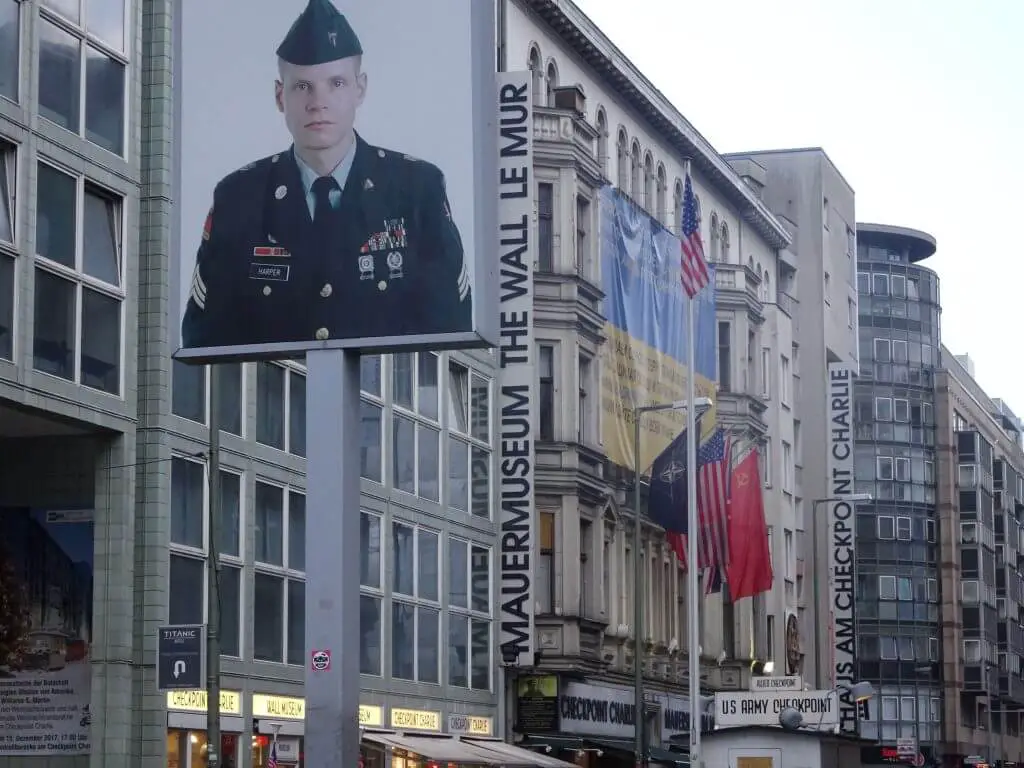
The next stop on this tour is Checkpoint ‘Charlie’. It is located on the corner of Friedrichstrasse and Zimmerstrasse. The checkpoint is a reminder of the former border crossing and the partition of Berlin. It was located in the American-occupied area of Berlin.
It is called Checkpoint Charlie because it was a third checkpoint opened in Berlin. The checkpoints were nicknamed by the West after the phonetic alphabet.
Checkpoint Charlie is the most famous crossing point in the Berlin Wall between East Berlin and West Berlin. It became the most famous because it was designated as the single crossing point for foreigners and members of the Allied forces (Western Bloc), on foot or by car.
My Mum told me that in the 80s during her visit to Berlin, she crossed Checkpoint Charlie from West to East and back again. She told me that it was somewhat of a tourist attraction back then too!
Why Checkpoint Charlie Is Famous
Checkpoint Charlie was active for 28 years, from 1961 to 1989. During that time it was the location of many notable and historical events.
It was the site of several daring escapes by East Berliners trying to get to the West. There were successful escapes, but unfortunately, there were also many escape attempts that ended in deaths.
In 1961 Checkpoint Charlie was the site of a stand-off between the U.S. and the Soviet soldiers. They had tanks positioned at the checkpoint for several hours. It was a historical moment in the Cold War.
The checkpoint was also used as a prisoner swap gate for people captured during the Cold War. Particularly people accused of being spies.
When the Berlin Wall came down in 1989, thousands of East Germans gathered at the checkpoint. They demanded the border guards to open the gates. After 4 hours, East Berliners flooded through the gate once the baffled border guards opened the barriers. It was the moment when people were allowed to move freely between East and West Berlin for the first time in nearly 30 years.
The famous border crossing has been featured in books and films. It was featured in the 1983 James Bond movie ‘Octopussy’ starring Roger Moore. It was also in the British Cold War spy novel ‘The Spy Who Came In From The Cold’ by John le Carre.
Visiting Checkpoint Charlie Today
Today when you visit the site of Checkpoint Charlie you will see replicas of the checkpoint and sandbags. There are also photographs representing the soldiers and border guards that would have been positioned at the checkpoint.
During your time at Checkpoint Charlie, take photos and imagine what life was like when the checkpoint was active.
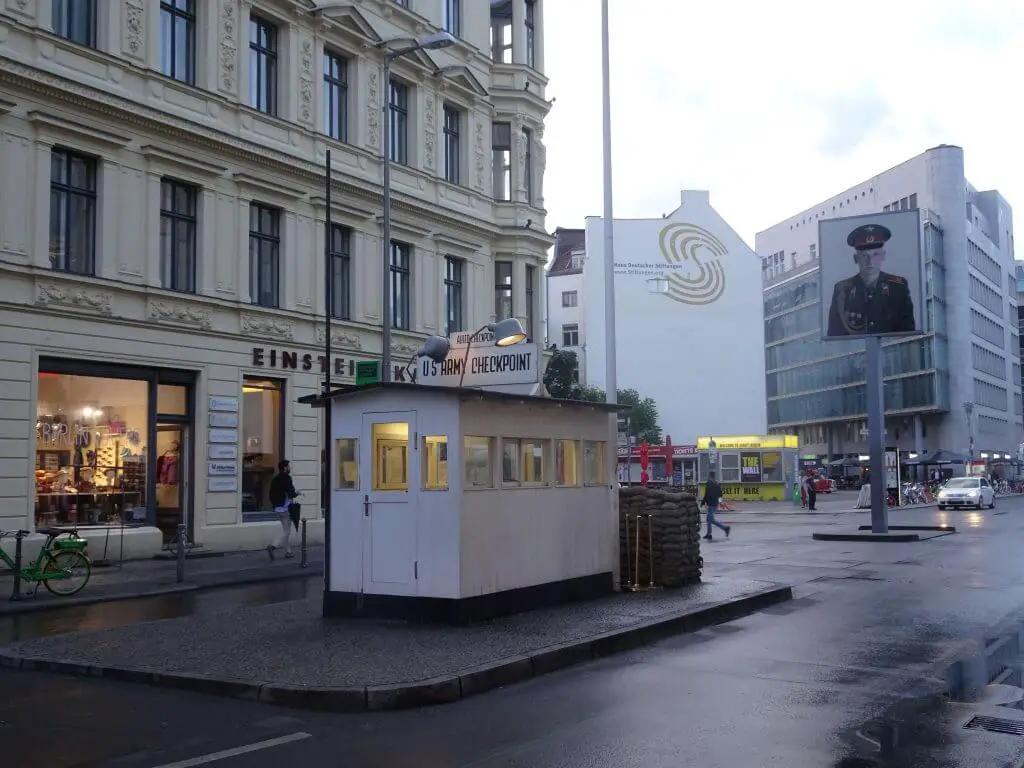
C. Topography of Terror
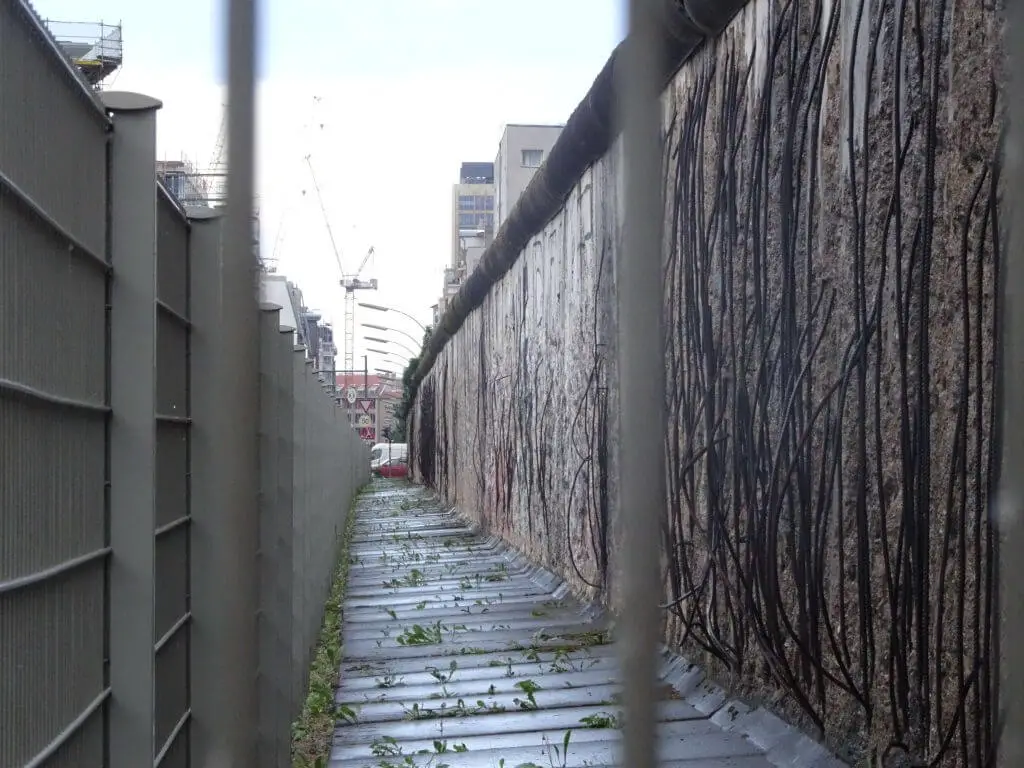
The Topography of Terror is a free and informative museum about the rise of the Nazi regime and life in Berlin during World War II. There are both indoor and outdoor exhibits, including a section of the Berlin Wall.
It is worth spending at least a couple of hours exploring if you can spare the time. Entry to the museum is FREE and includes an audio guide.
If you don’t have time to check it out then you can always revisit the museum at a later date. Continue with this self-guided tour and make a note to go back to the Topography of Terror!
During your stay in Berlin, I would highly recommend visiting the Topography of Terror. The museum is especially worthwhile if you want to learn more about World War II history in Berlin. I learned a lot during my visit and it is an excellently curated museum.
It is worth bearing in mind that a lot of the footage, photographs and content in the museum are distressing. So it is not advised for sensitive viewers and care should be taken with children.
To fully appreciate the Topography of Terror Museum, you will need around 2-3 hours for your visit. The audio guide has around 1 hour of content available in 22 languages. The museum is open from 10 am – 6 pm seven days a week. Visit their website here.
D. Hitler’s Bunker (Führerbunker)
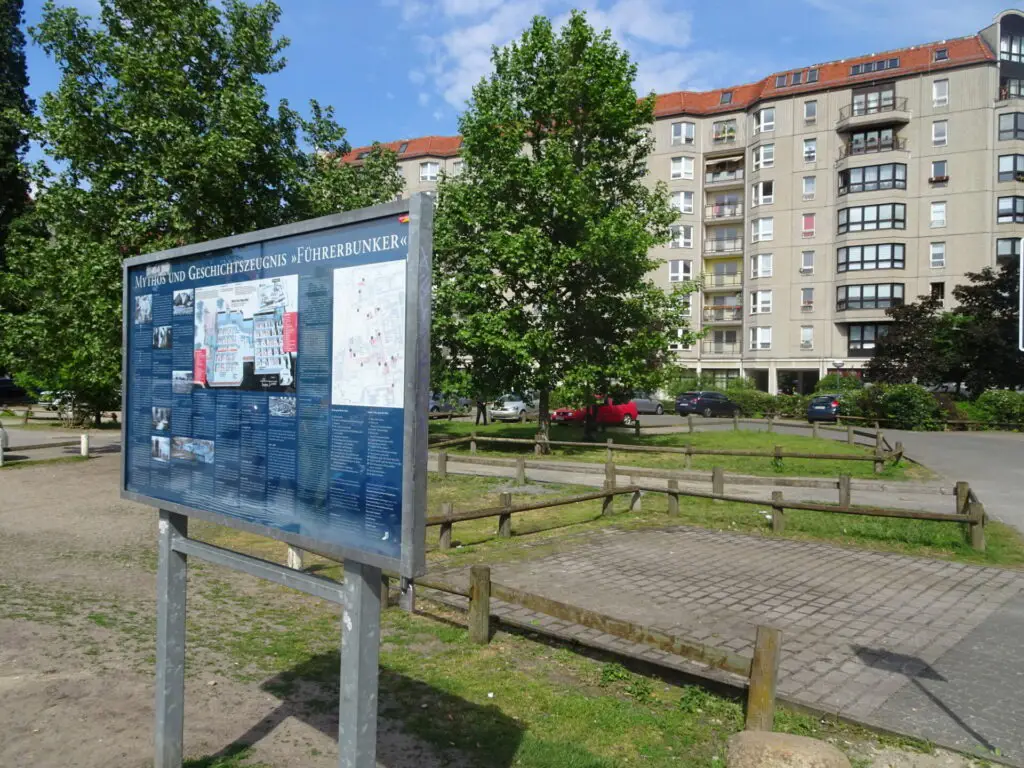
Stumble upon this car park and you’d probably have no idea of the significance of where you’re standing. That is unless you notice the humble sign as shown in the photograph above. This is the site of Hitler’s secret bunker!
Hitler’s bunker was built for him as an air-raid shelter. The complex was a large underground set of around 30 rooms on various levels. The rooms were connected by corridors and stairways. The walls and roofs were made of concrete several meters thick and doors of heavy steel. Passages were leading to above-ground buildings and gardens of the Reich Chancellery (the Office of the Chancellor) for entry/exit points.
Hitler’s Death & The End Of World War II
Towards the end of the war in 1945, Hitler and his close associates moved into the bunker. With many armies advancing into Berlin and disintegrating Nazi forces, Hitler knew it was the end. He married his long-time mistress Eva Braun in a midnight ceremony inside the bunker. The next day they died by suicide, Hitler by shooting himself and Braun by taking cyanide. Hitler’s associates, under his instruction, before he died, took Hitler’s and Braun’s bodies into the garden. They doused them with petrol and set them alight. They burned for several hours but were not completely disintegrated. Running out of time, the staff buried them in a bomb crater.
Despite the announcement of Hitler’s death, many people didn’t believe it. In the aftermath, upon discovery of the bunker, the burned remains were searched for by the Soviet army. Skull fragments and teeth of the lower jaw were found. They were taken to Moscow and remain there to this day.
Many conspiracy theories remain as to whether Hitler was alive or dead. But a recent study declares the story of what happened in the bunker is true and Hitler died in 1945.
Hitler’s Secret Bunker After World War II
After the war, there were many attempts to destroy the bunker by the government. This was because they feared that it would become a site for Nazi sympathizers to gather.
During the time of the Berlin Wall, the area remained largely undeveloped. After the fall, the government allowed building construction in the area – mainly of residential apartment blocks and car parks. The idea was that the building would be anonymous and unremarkable, to not draw attention.
The bunker was largely forgotten. Many people did not know the exact location of the site until a small information board was erected in 2006. The information board shows diagrams of the bunker and information about its history.
Take time to have a look at the site and read the information sign before moving on to the next stop – the Memorial to the Murdered Jews of Europe.
E. Memorial To The Murdered Jews Of Europe (Holocaust Memorial)
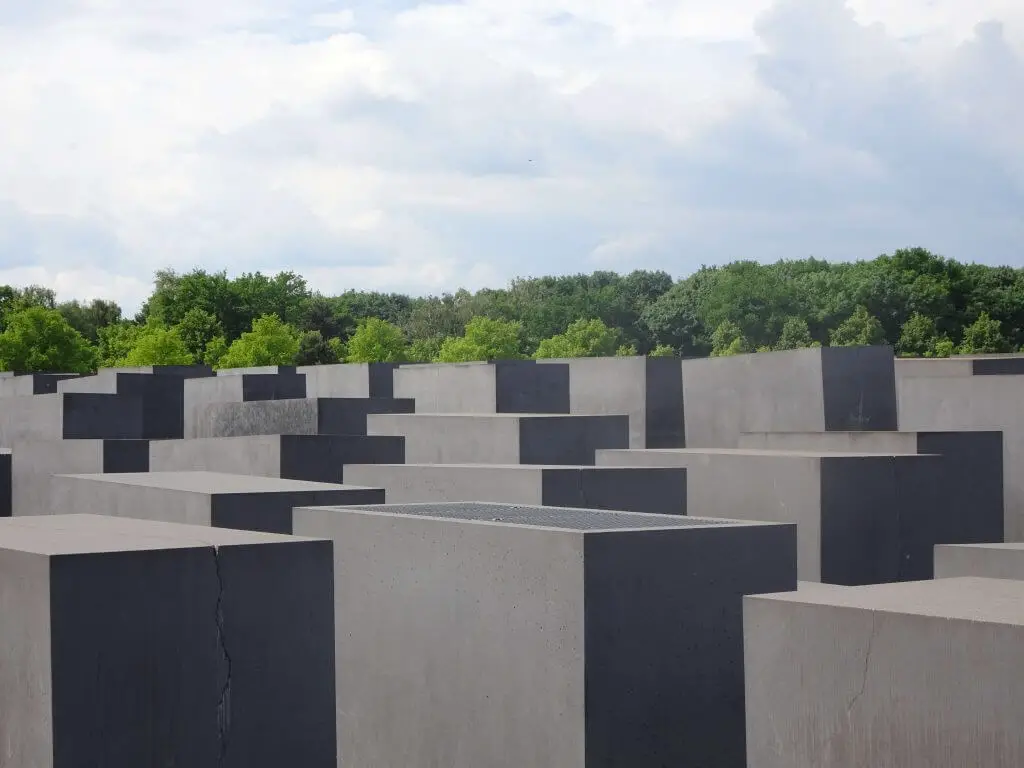
The next stop on this self-guided tour of World War II Berlin is the Memorial to the Murdered Jews of Europe. This harrowing memorial is a stark reminder of the crimes committed during the holocaust and the victims of World War II.
What Do The Blocks Represent At The Holocaust Memorial?
The memorial consists of 2,711 concrete slabs arranged in a grid pattern on a sloped field. The number has no symbolic significance. However, the design aims to represent an ordered system that has lost touch with human reason (Source: Stifung-Denkmal).
You can ‘interact’ and walk along the narrow alleyways between the concrete slabs.
During my time visiting the Memorial to the Murdered Jews of Europe, I was struck with emotion. I felt that the massive blocks of concrete triggered a feeling of isolation. You cannot see over the top of them and you cannot hear or see the city of Berlin. It is representative of the segregation and confinement that Jews and others had during the Nazi regime.
In addition, the grey colour of the concrete is dull and lacks vibrancy. This can be interpreted as the loss of identity and community for victims during the Holocaust.
The blocks could also be seen to resemble rows of coffins or gravestones.
Take time here to reflect on the history and the people whose lives were affected.
Underground Information Centre
Below the memorial, there is an underground information centre that shows historical photographs, film footage and biographies of the victims. A FREE audio tour is available at the information centre.
To fully appreciate the Holocaust Information Centre, allow 1-2 hours for your visit. The information centre is open 10 am – 6 pm Tuesday – Sunday (closed Christmas and New Year holidays). Visit their website here.
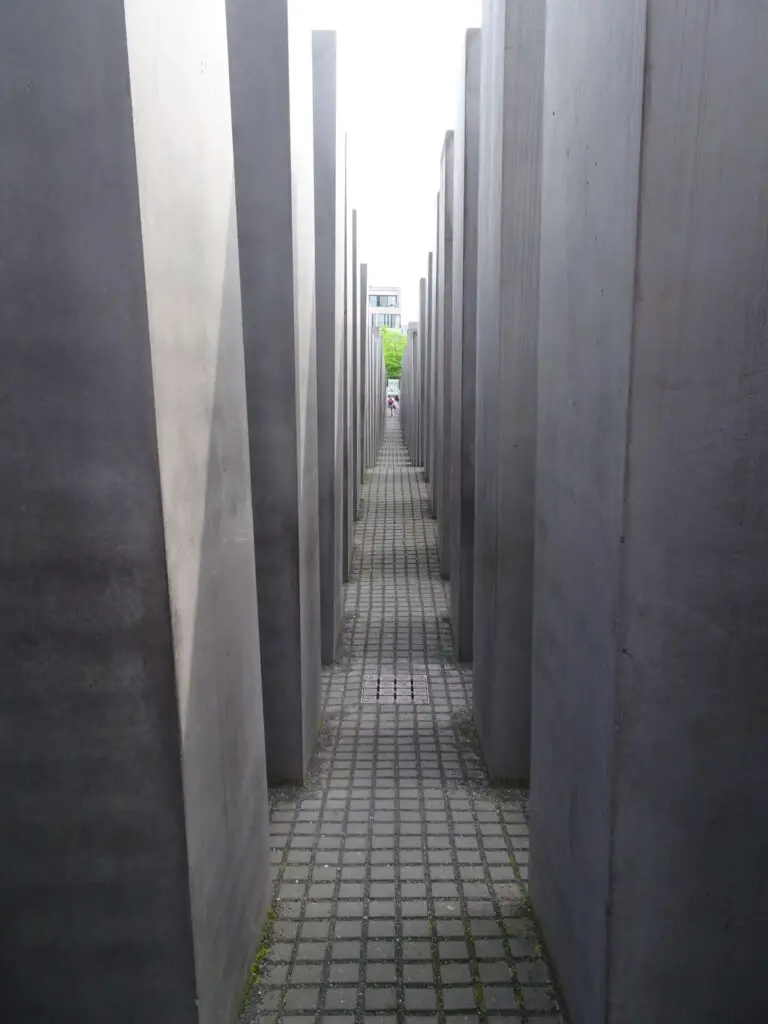
Related Read: Berlin’s LGBTQ+ History Walking Tours & The Memorial To Homosexuals Persecuted During The Nazi Era
F. Brandenburg Gate (Brandenburger Tor)
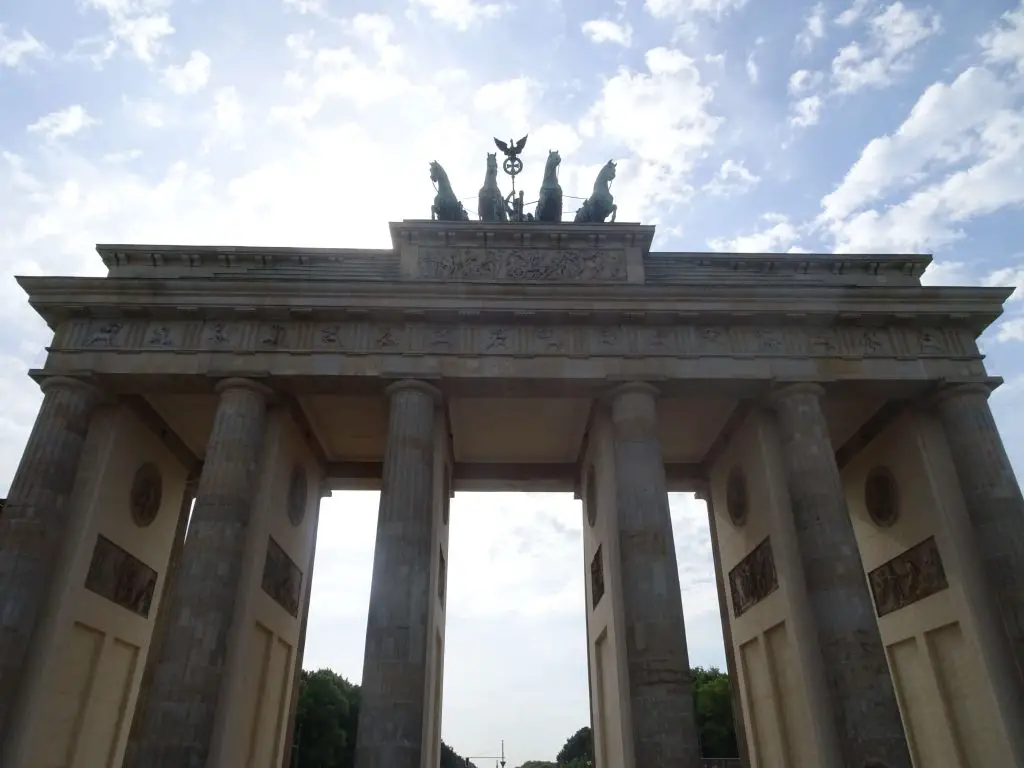
The next top on the tour is the most iconic location in Berlin. The Brandenburg Gate is a well-known symbol of Berlin and Germany and has a long and varied history. The gate was originally built in the 18th century. It was on the site of an old gate which marked the start of the road from Berlin to the town of Brandenburg. It is Berlin’s only surviving historical gate.
History Of The Brandenburg Gate
The Brandenburg Gate was built in 1791. It is in a neo-classical style of architecture under the orders of the Prussian King Friedrich Wilhelm II. It was built at the end of the boulevard of lime trees – Unter den Linden (Under the Linden (lime trees)).
When Napoleon invaded Berlin in 1806, he stole the statue at the top of the gate (Quadriga – the chariot drawn by 4 horses). Napoleon took it back to Paris as a sign of his victory. When he was defeated at the Battle of Waterloo in 1815, the Quadriga was returned to Berlin.
The Brandenburg Gate Before, During & After World War II In Berlin
During the time of the Nazis, the Brandenburg Gate was a political symbol for the party. In 1933, a procession led through the gate celebrated Hitler’s seizure of power.
Throughout World War II, the Brandenburg Gate suffered greatly from damage by bullets and explosions. Despite this, it was one of the few buildings still standing in ruins of the Pariser Platz square (which stands in front of the gate) at the end of the war in 1945.
There was a joint effort to restore the gate somewhat after the war. But then when the Berlin Wall was erected in 1961, the gate remained in the exclusion zone. With walls on either side of it, for over 20 years it was inaccessible to anybody until the wall came down in 1989.
A Symbol Of Reunification
100,000 people gathered there for the official reopening of the gate in 1990. As it had previously been a symbol of division, when the wall fell rather ironically the gate became a symbol for the reunification of East and West. The gate was completely refurbished from 2000-2002, to how it looks today.
G. Site of the Nazi Book Burning (Memorial to May 10, 1933)


On the 10th of May 1933, approximately 20,000 books were burned by the Nazis at the Bebelplatz in central Berlin. It was conducted by the German Student Association, students of which would have studied at the university buildings surrounding the Bebelplatz.
Today, there is a memorial built into the floor of the plaza, with a glass plate which gives a view into a room below, with empty bookcases – enough to fill the 20,000 books burned on the site.
H. Berlin Wall Memorial Park
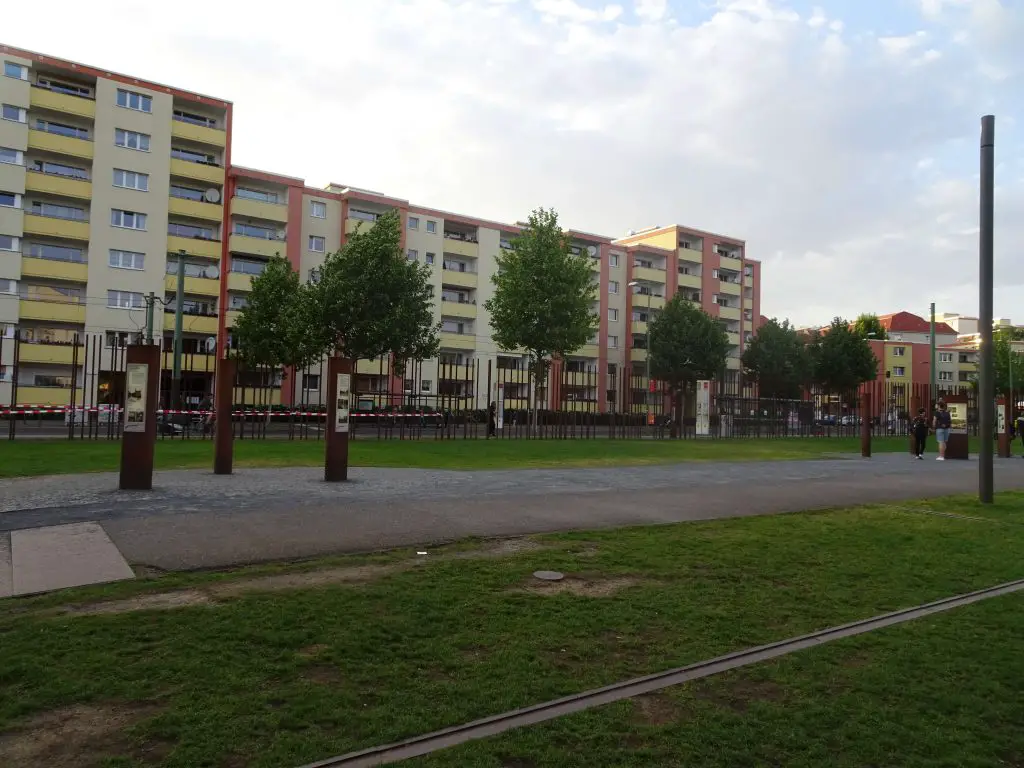
The Berlin Wall Memorial Park is an outside memorial that stretches 1.4km along Bernauer Strass and commemorates the division of Berlin and the victims of those who died there.
It shares the story of life in the neighbourhood before and after the wall was built. It shows how the wall tore families apart and how they risked their lives trying to cross it. Many attempted to cross the wall by jumping and running through ‘No Man’s Land’, and by building a series of tunnel networks which ran underneath the city.
This less visited site contains the largest in tact section of the Berlin Wall which has remained original to as it was when it was first built. This part of the wall contains no graffiti (unlike the East Side Gallery). It is also not possible to cross to the other side which helps convey an impression of how it would have been up to the end of the 1980s.
The rest of the ‘wall’ is made up of metal poles. This gives you a sense of its intimidating division, as well as the expanse of the gap between the two walls and the horrifying extent the authorities went to stop anyone crossing it.
It’s worth spending a couple of hours here taking a look at the interesting and comprehensive information signs, maps, photographs and audio clips which accompany the outdoor exhibition. There is also an indoor visitor centre (link to their website) with a multimedia exhibition across the road.
I. Berlin Wall Watchtower (Ackerstrasse)

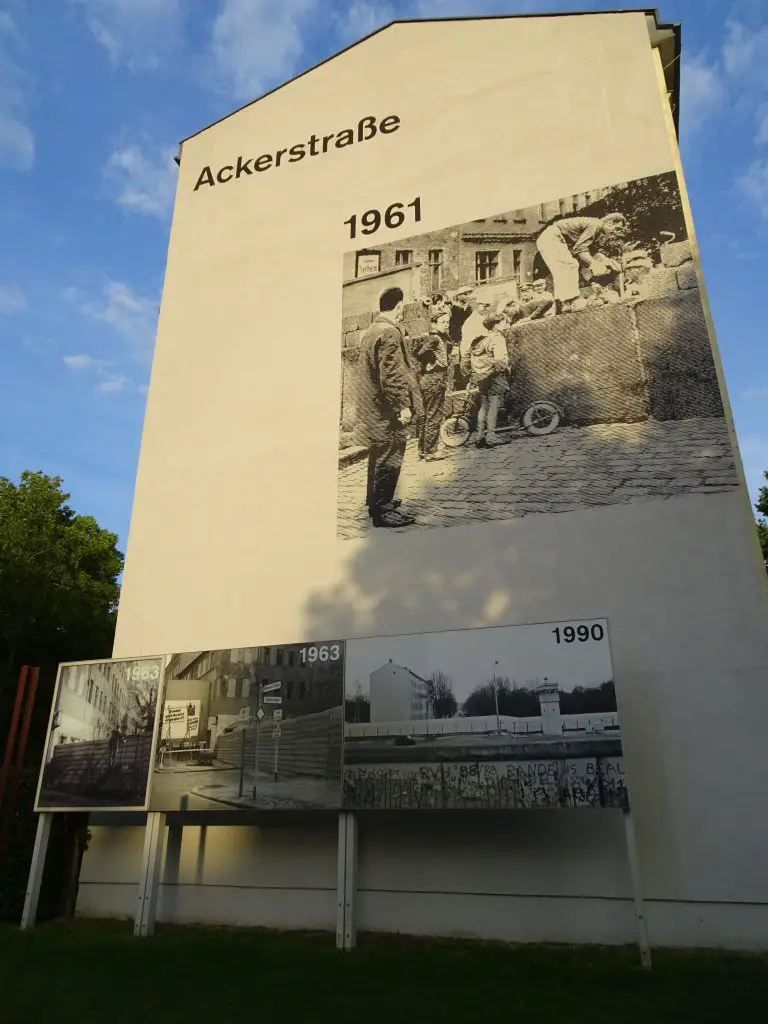
Of more than 300 watchtowers during the time of the Berlin Wall, just a few remain dotted around the city. One of these is the watchtower at Ackerstrasse, only the top of which is visible due to the large wall which has been erected in front of it. It is a protection barrier, to stop it from being dismantled or damaged, and so it is one of the few which remains preserved in its original form. It is part of the Berlin Wall Memorial.
J. Cross of the Reconciliation Church (Kapelle der Versöhnung)

The final stop on this tour is the site of the former Church of Reconciliation.
To completely erect the Berlin Wall, many buildings were destroyed as they stood on the borderline between East and West. One of these buildings was the Church of Reconciliation, where today the new Chapel of Reconciliation stands, a restoration project in memory of the old church.
Before the Church was destroyed, it stood in ‘No Man’s Land’, with the Western Wall running directly in front of it and the Eastern Wall directly behind it. This prevented access to anyone except the border guards who used its tower as an observation post.
In 1985, it was decided that the church should be destroyed and was blown up by the GDR. During the deconstruction, the cross of the spire fell off and, although bent, remained largely intact. It was recovered and hidden by cemetery workers for many years, until in 1995 on the Day of Repentance, the cross was returned to its original site.
Free Self-Guided World War II Walking/Cycling Tour In Berlin – Thanks For Reading!
This guide has explored World War II landmarks in Berlin and allowed you to learn the history of the city with a free self-guided tour. I hope that this guide has been useful to you and allowed you to walk or cycle the city at your own pace and discover important sites in Germany. Thanks so much for reading! – Lauren x
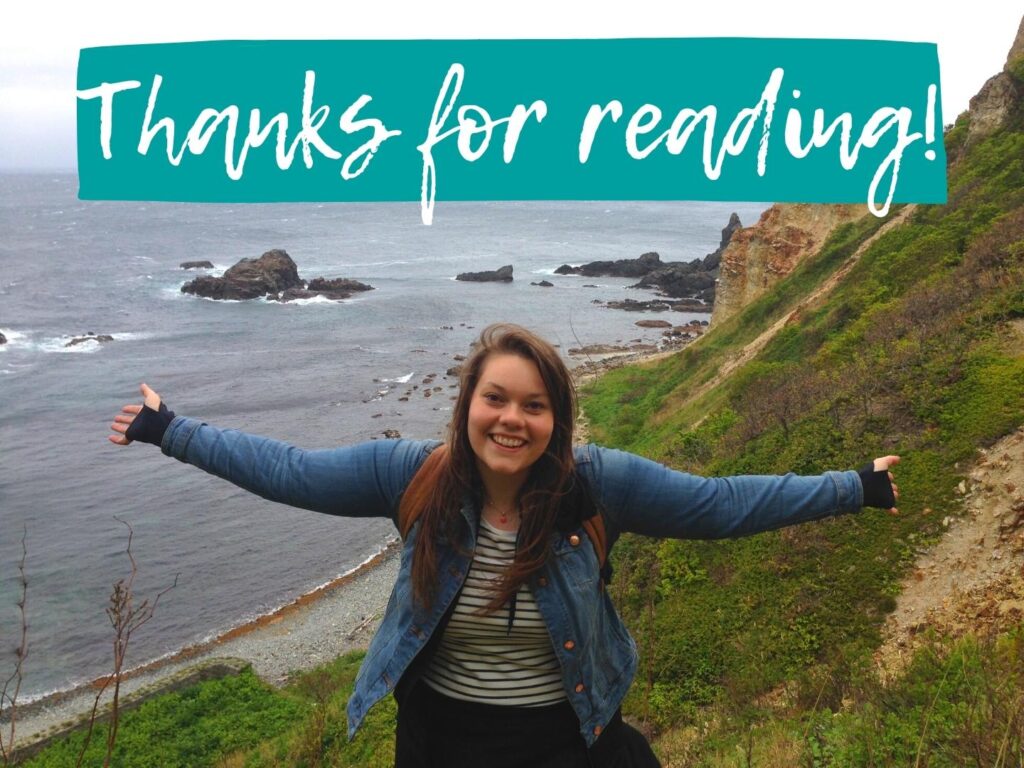
Did you find this article useful? Let me know in the comments or join me on Twitter, Facebook, Pinterest and Instagram. Buy me a coffee here!
If you enjoyed this post, share it with a friend! 💌
My Travel Resources guide will help you get the best deals when booking your next trip – check it out here!


